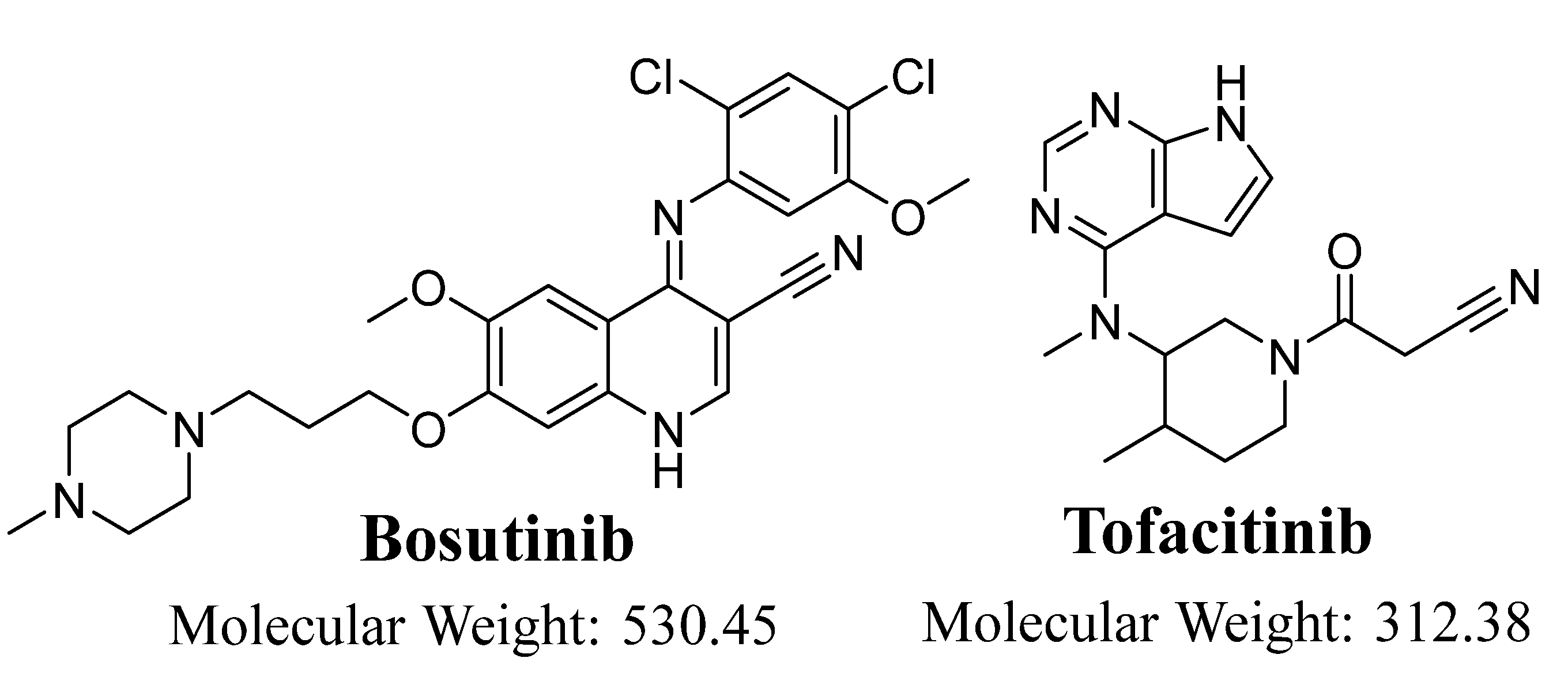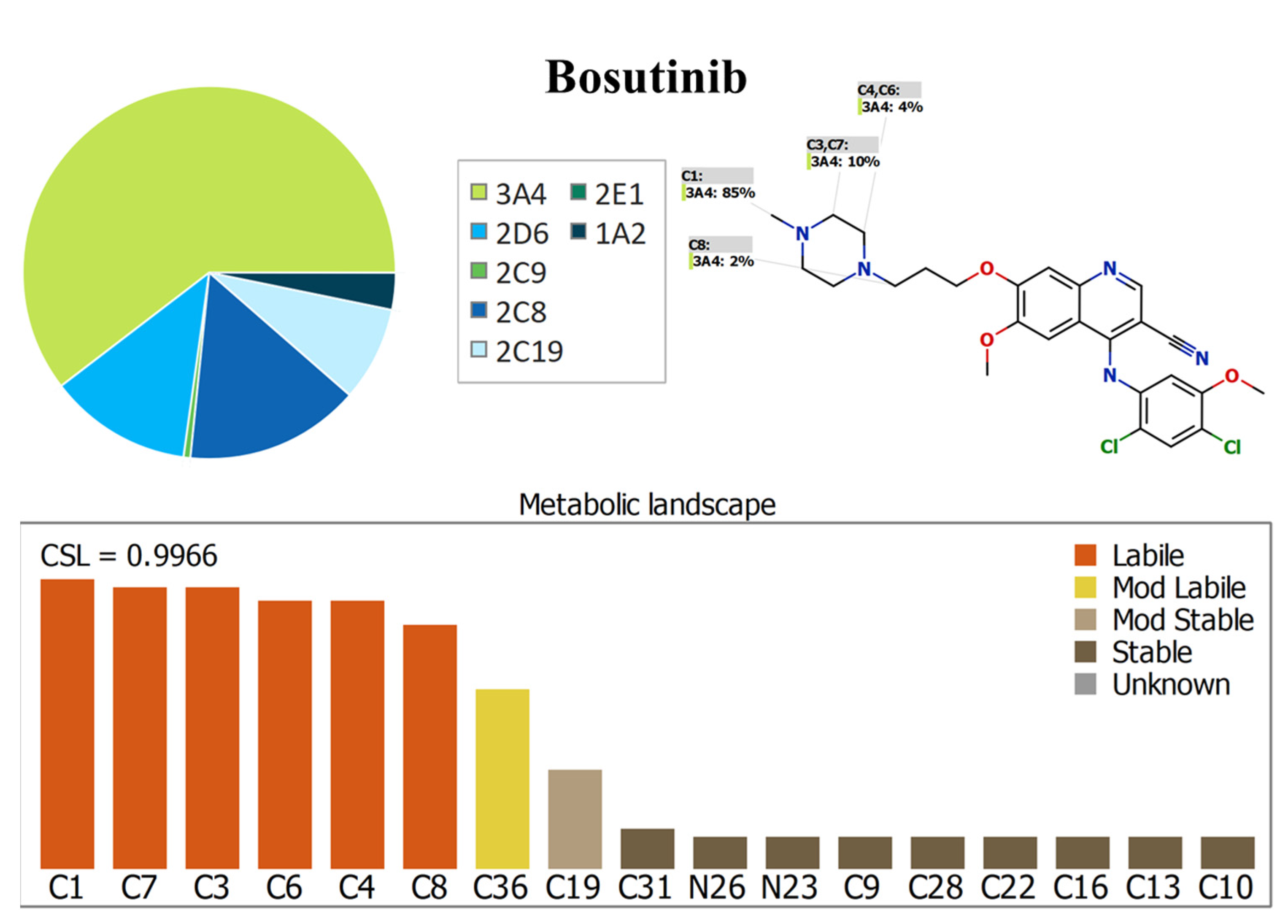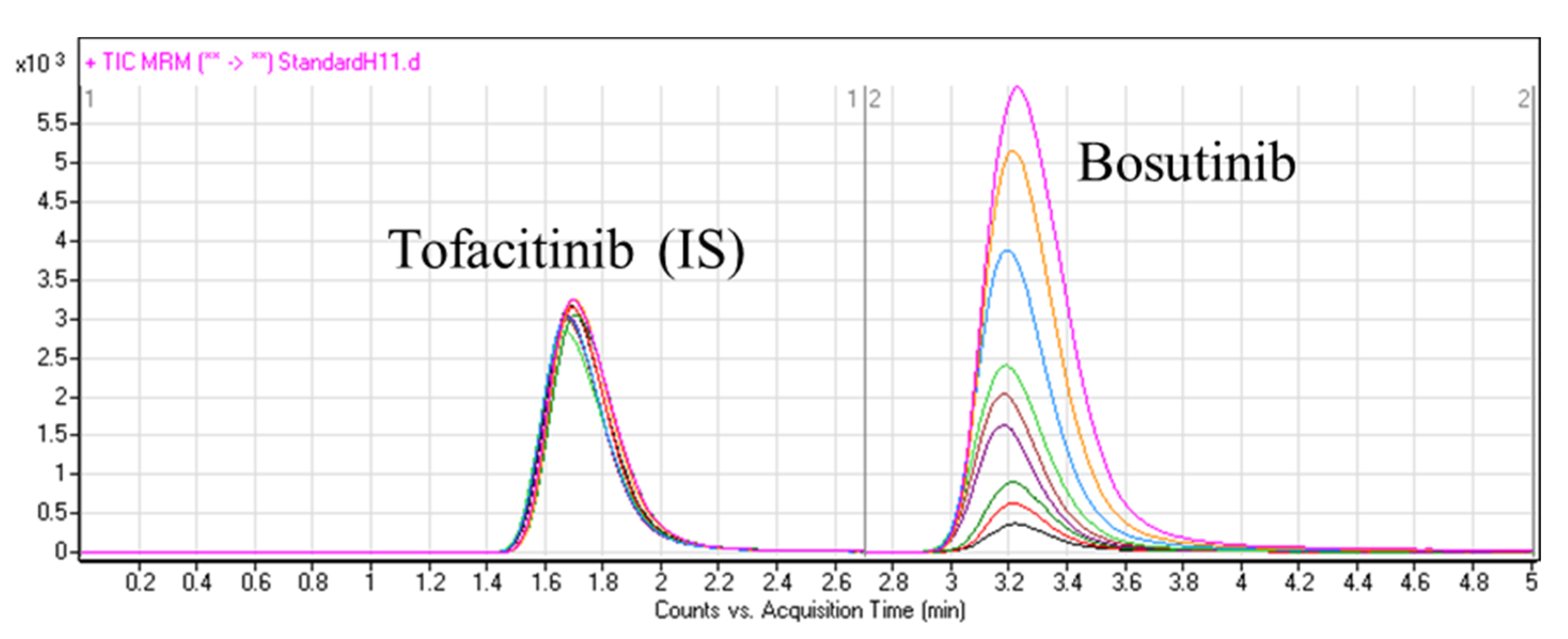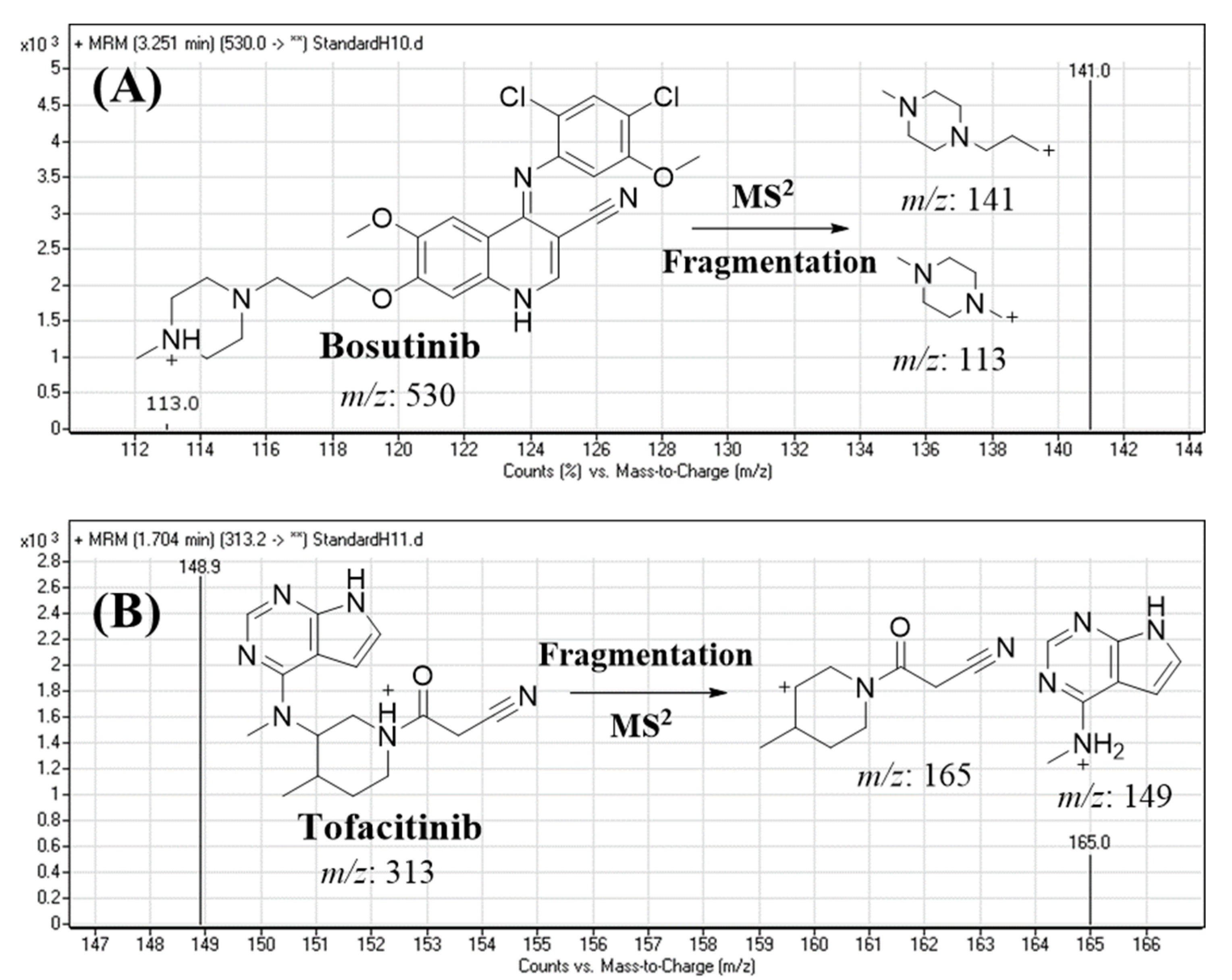Rapid LC-MS/MS Bosutinib Quantification with Applications in Metabolic Stability Estimation
Abstract
:1. Introduction
2. Results
2.1. In Silico BOS Metabolic Stability
2.2. LC-MS/MS Method Development
2.3. Method Validation
2.3.1. Specificity
2.3.2. Linearity and Sensitivity
2.3.3. Precision and Accuracy
2.4. In Vitro Metabolic Stability of BOS
3. Materials and Methods
3.1. Chemicals and Reagents
3.2. In Silico BOS Metabolic Stability Evaluation
3.3. Instrumentation and Conditions
3.4. Preparation of the Standard Solutions
3.5. Sample Preparation and Construction of the Calibration Curve
3.6. BOS Metabolic Stability
4. Conclusions
Author Contributions
Funding
Institutional Review Board Statement
Informed Consent Statement
Data Availability Statement
Acknowledgments
Conflicts of Interest
Sample Availability
References
- Picard, S.; Titier, K.; Etienne, G.; Teilhet, E.; Ducint, D.; Bernard, M.A.; Lassalle, R.; Marit, G.; Reiffers, J.; Begaud, B.; et al. Trough imatinib plasma levels are associated with both cytogenetic and molecular responses to standard-dose imatinib in chronic myeloid leukemia. Blood 2007, 109, 3496–3499. [Google Scholar] [CrossRef] [PubMed]
- Druker, B.J.; Talpaz, M.; Resta, D.J.; Peng, B.; Buchdunger, E.; Ford, J.M.; Lydon, N.B.; Kantarjian, H.; Capdeville, R.; Ohno-Jones, S. Efficacy and safety of a specific inhibitor of the BCR-ABL tyrosine kinase in chronic myeloid leukemia. N. Engl. J. Med. 2001, 344, 1031–1037. [Google Scholar] [CrossRef] [PubMed]
- Demetri, G.D.; Von Mehren, M.; Blanke, C.D.; Van den Abbeele, A.D.; Eisenberg, B.; Roberts, P.J.; Heinrich, M.C.; Tuveson, D.A.; Singer, S.; Janicek, M. Efficacy and safety of imatinib mesylate in advanced gastrointestinal stromal tumors. N. Engl. J. Med. 2002, 347, 472–480. [Google Scholar] [CrossRef] [PubMed]
- Cools, J.; DeAngelo, D.J.; Gotlib, J.; Stover, E.H.; Legare, R.D.; Cortes, J.; Kutok, J.; Clark, J.; Galinsky, I.; Griffin, J.D. A tyrosine kinase created by fusion of the PDGFRA and FIP1L1 genes as a therapeutic target of imatinib in idiopathic hypereosinophilic syndrome. N. Engl. J. Med. 2003, 348, 1201–1214. [Google Scholar] [CrossRef] [PubMed]
- Gorre, M.E.; Mohammed, M.; Ellwood, K.; Hsu, N.; Paquette, R.; Rao, P.N.; Sawyers, C.L. Clinical resistance to STI-571 cancer therapy caused by BCR-ABL gene mutation or amplification. Science 2001, 293, 876–880. [Google Scholar] [CrossRef]
- Talpaz, M.; Shah, N.P.; Kantarjian, H.; Donato, N.; Nicoll, J.; Paquette, R.; Cortes, J.; O’Brien, S.; Nicaise, C.; Bleickardt, E. Dasatinib in imatinib-resistant Philadelphia chromosome–positive leukemias. N. Engl. J. Med. 2006, 354, 2531–2541. [Google Scholar] [CrossRef]
- Kantarjian, H.M.; Giles, F.; Gattermann, N.; Bhalla, K.; Alimena, G.; Palandri, F.; Ossenkoppele, G.J.; Nicolini, F.-E.; O’Brien, S.G.; Litzow, M. Nilotinib (formerly AMN107), a highly selective BCR-ABL tyrosine kinase inhibitor, is effective in patients with Philadelphia chromosome–positive chronic myelogenous leukemia in chronic phase following imatinib resistance and intolerance. Blood Am. Soc. Hematol. 2007, 110, 3540–3546. [Google Scholar] [CrossRef]
- Shah, N.P.; Skaggs, B.J.; Branford, S.; Hughes, T.P.; Nicoll, J.M.; Paquette, R.L.; Sawyers, C.L. Sequential ABL kinase inhibitor therapy selects for compound drug-resistant BCR-ABL mutations with altered oncogenic potency. J. Clin. Investig. 2007, 117, 2562–2569. [Google Scholar] [CrossRef]
- US Food and Drug Administration. FDA Grants Accelerated Approval to Bosutinib for Treatment of Newly-Diagnosed PH + CML. U.S. Food and Drug Administration. FDA Grants Accelerated Approval to Bosutinib for Treatment of Newly-Diagnosed PH+ CML. 2017. Available online: https://www.fda.gov/drugs/resources-information-approved-drugs/fda-grants-accelerated-approval-bosutinib-treatment-newly-diagnosed-ph-cml (accessed on 10 November 2022).
- Golas, J.M.; Arndt, K.; Etienne, C.; Lucas, J.; Nardin, D.; Gibbons, J.; Frost, P.; Ye, F.; Boschelli, D.H.; Boschelli, F. SKI-606, a 4-anilino-3-quinolinecarbonitrile dual inhibitor of Src and Abl kinases, is a potent antiproliferative agent against chronic myelogenous leukemia cells in culture and causes regression of K562 xenografts in nude mice. Cancer Res. 2003, 63, 375–381. [Google Scholar]
- Cortes, J.; Kantarjian, H.M.; Baccarani, M.; Brummendorf, T.H.; Liu, D.; Ossenkoppele, G.; Volkert, A.D.; Hewes, B.; Moore, L.; Zacharchuk, C. A Phase 1/2 Study of SKI-606, a Dual Inhibitor of Src and Abl Kinases, in Adult Patients with Philadelphia Chromosome Positive (Ph+) Chronic Myelogenous Leukemia (CML) or Acute Lymphocytic Leukemia (ALL) Relapsed, Refractory or Intolerant of Imatinib. Blood 2006, 108, 168. [Google Scholar] [CrossRef]
- Cortes, J.; Kantarjian, H.; Brummendorf, T.; Khoury, H.; Kim, D.; Turkina, A.; Volkert, A.; Wang, J.; Arkin, S.; Gambacorti-Passerini, C. Safety and efficacy of bosutinib (SKI-606) in patients (pts) with chronic phase (CP) chronic myeloid leukemia (CML) following resistance or intolerance to imatinib (IM). J. Clin. Oncol. 2010, 28 (Suppl. S15), 6502. [Google Scholar] [CrossRef]
- Ault, P.S.; Rose Pharm, D.J.; Nodzon Ph, D.L.; Kaled, E.S. Bosutinib Therapy in Patients with Chronic Myeloid Leukemia: Practical Considerations for Management of Side Effects. J. Adv. Pract. Oncol. 2016, 7, 160–175. [Google Scholar]
- Keller, G.; Schafhausen, P.; Brümmendorf, T.H. Bosutinib. Small Mol. Oncol. 2010, 184, 119–127. [Google Scholar]
- Houston, J.B. Utility of in vitro drug metabolism data in predicting in vivo metabolic clearance. Biochem. Pharmacol. 1994, 47, 1469–1479. [Google Scholar] [CrossRef]
- Obach, R.S.; Baxter, J.G.; Liston, T.E.; Silber, B.M.; Jones, B.C.; MacIntyre, F.; Rance, D.J.; Wastall, P. The prediction of human pharmacokinetic parameters from preclinical and in vitro metabolism data. J. Pharmacol. Exp. Ther. 1997, 283, 46–58. [Google Scholar]
- Nichols, J.W.; Schultz, I.R.; Fitzsimmons, P.N. In vitro-in vivo extrapolation of quantitative hepatic biotransformation data for fish. I. A review of methods, and strategies for incorporating intrinsic clearance estimates into chemical kinetic models. Aquat. Toxicol. 2006, 78, 74–90. [Google Scholar] [CrossRef]
- Pelkonen, O.; Turpeinen, M. In vitro-in vivo extrapolation of hepatic clearance: Biological tools, scaling factors, model assumptions and correct concentrations. Xenobiotica 2007, 37, 1066–1089. [Google Scholar] [CrossRef]
- Krishna, M.V.; Padmalatha, K.; Madhavi, G. In vitro Metabolic Stability of Drugs and Applications of LC-MS in Metabolite Profiling. Drug Metab. 2021, 77. [Google Scholar] [CrossRef]
- Baranczewski, P.; Stanczak, A.; Sundberg, K.; Svensson, R.; Wallin, A.; Jansson, J.; Garberg, P.; Postlind, H. Introduction to in vitro estimation of metabolic stability and drug interactions of new chemical entities in drug discovery and development. Pharmacol. Rep. 2006, 58, 453. [Google Scholar]
- Tan, L.; Kirchmair, J. Software for metabolism prediction. Drug Metab. Predict. 2014, 27–52. [Google Scholar] [CrossRef]
- Hunt, P.A.; Segall, M.D.; Tyzack, J.D. WhichP450: A multi-class categorical model to predict the major metabolising CYP450 isoform for a compound. J. Comput. Aided Mol. Des. 2018, 32, 537–546. [Google Scholar] [CrossRef] [PubMed]
- Shin, Y.G.; Le, H.; Khojasteh, C.; ECA Hop, C. Comparison of metabolic soft spot predictions of CYP3A4, CYP2C9 and CYP2D6 substrates using MetaSite and StarDrop. Comb. Chem. High Throughput Screen. 2011, 14, 811–823. [Google Scholar] [CrossRef] [PubMed]
- Leahy, D.E. Integrating invitro ADMET data through generic physiologically based pharmacokinetic models. Expert Opin. Drug Metab. Toxicol. 2006, 2, 619–628. [Google Scholar] [CrossRef] [PubMed]





| Nominal Conc. (ng/mL) | Mean a | Standard Deviation (SD) | Precision (%) | Accuracy (%) |
|---|---|---|---|---|
| 5 | 5.07 | 0.05 | 1.00 | 101.43 |
| 10 | 10.16 | 0.14 | 1.35 | 101.55 |
| 15 | 15.11 | 0.04 | 0.27 | 100.74 |
| 20 | 19.53 | 0.30 | 1.53 | 97.65 |
| 30 | 29.70 | 0.19 | 0.65 | 99.01 |
| 40 | 39.40 | 0.20 | 0.52 | 98.51 |
| 50 | 50.56 | 0.20 | 0.40 | 101.11 |
| 100 | 100.70 | 0.34 | 0.33 | 100.70 |
| 150 | 150.04 | 1.08 | 0.72 | 100.03 |
| 200 | 199.66 | 0.76 | 0.38 | 99.83 |
| Day of Analysis | Measured Concentration of Bosutinib in HLM Matrices | |||||
|---|---|---|---|---|---|---|
| LQC (15 ng mL−1) | MQC (50 ng mL−1) | HQC (150 ng mL−1) | ||||
| Day 1 | 15.18 | 50.61 | 151.22 | |||
| 15.08 | 49.96 | 149.09 | ||||
| 15.14 | 50.77 | 150.52 | ||||
| 15.08 | 50.74 | 149.49 | ||||
| 15.10 | 50.62 | 148.16 | ||||
| 15.14 | 50.32 | 148.86 | ||||
| 15.00 | 50.60 | 151.22 | ||||
| 15.04 | 50.31 | 148.94 | ||||
| 15.05 | 49.90 | 148.39 | ||||
| 15.12 | 50.63 | 151.20 | ||||
| 15.12 | 50.30 | 148.84 | ||||
| 15.15 | 50.79 | 150.61 | ||||
| Day 2 | 15.00 | 50.22 | 150.25 | |||
| 15.03 | 50.00 | 150.46 | ||||
| 15.07 | 50.01 | 150.12 | ||||
| 15.04 | 50.05 | 150.13 | ||||
| 15.02 | 50.08 | 150.31 | ||||
| 15.16 | 50.31 | 149.90 | ||||
| Day 3 | 15.12 | 50.18 | 150.48 | |||
| 15.05 | 50.05 | 150.12 | ||||
| 15.07 | 50.15 | 149.79 | ||||
| 15.00 | 49.99 | 150.12 | ||||
| 15.01 | 50.15 | 150.43 | ||||
| 15.15 | 50.04 | 150.51 | ||||
| Intra-day * | Inter-day ** | Intra-day | Inter-day | Intra-day | Inter-day | |
| Mean | 15.10 | 15.08 | 50.46 | 50.28 | 149.71 | 149.97 |
| SD | 0.05 | 0.06 | 0.30 | 0.29 | 1.16 | 0.86 |
| %RSD | 0.33 | 0.37 | 0.60 | 0.57 | 0.78 | 0.57 |
| %RE | 0.66 | 0.53 | 0.92 | 0.56 | −0.19 | −0.02 |
| Time (min.) | Mean a (ng/mL) | X b | LN X c | Analytical Parameters |
|---|---|---|---|---|
| 0 | 195.00 | 100 | 4.61 | Linear regression equation: y = −0.034339x + 4.592 |
| 2.5 | 174.27 | 89.36 | 4.49 | |
| 7.5 | 146.89 | 75.32 | 4.32 | R² = 0.9964 |
| 15 | 117.69 | 60.35 | 4.10 | |
| 20 | 95.60 | 49.02 | 3.89 | Slope: −0.0254 |
| 30 | 91.37 | 46.85 | 3.85 | |
| 40 | 85.00 | 43.58 | 3.77 | t1/2: 20.21 min |
| 50 | 79.93 | 40.98 | 3.71 | CLint: 34.3 µL/min/mg |
| 60 | 77.72 | 39.85 | 3.69 | |
| 70 | 74.07 | 37.98 | 3.64 |
Disclaimer/Publisher’s Note: The statements, opinions and data contained in all publications are solely those of the individual author(s) and contributor(s) and not of MDPI and/or the editor(s). MDPI and/or the editor(s) disclaim responsibility for any injury to people or property resulting from any ideas, methods, instructions or products referred to in the content. |
© 2023 by the authors. Licensee MDPI, Basel, Switzerland. This article is an open access article distributed under the terms and conditions of the Creative Commons Attribution (CC BY) license (https://creativecommons.org/licenses/by/4.0/).
Share and Cite
Attwa, M.W.; Alanazi, M.M. Rapid LC-MS/MS Bosutinib Quantification with Applications in Metabolic Stability Estimation. Molecules 2023, 28, 1641. https://doi.org/10.3390/molecules28041641
Attwa MW, Alanazi MM. Rapid LC-MS/MS Bosutinib Quantification with Applications in Metabolic Stability Estimation. Molecules. 2023; 28(4):1641. https://doi.org/10.3390/molecules28041641
Chicago/Turabian StyleAttwa, Mohamed W., and Mohammed M. Alanazi. 2023. "Rapid LC-MS/MS Bosutinib Quantification with Applications in Metabolic Stability Estimation" Molecules 28, no. 4: 1641. https://doi.org/10.3390/molecules28041641
APA StyleAttwa, M. W., & Alanazi, M. M. (2023). Rapid LC-MS/MS Bosutinib Quantification with Applications in Metabolic Stability Estimation. Molecules, 28(4), 1641. https://doi.org/10.3390/molecules28041641








